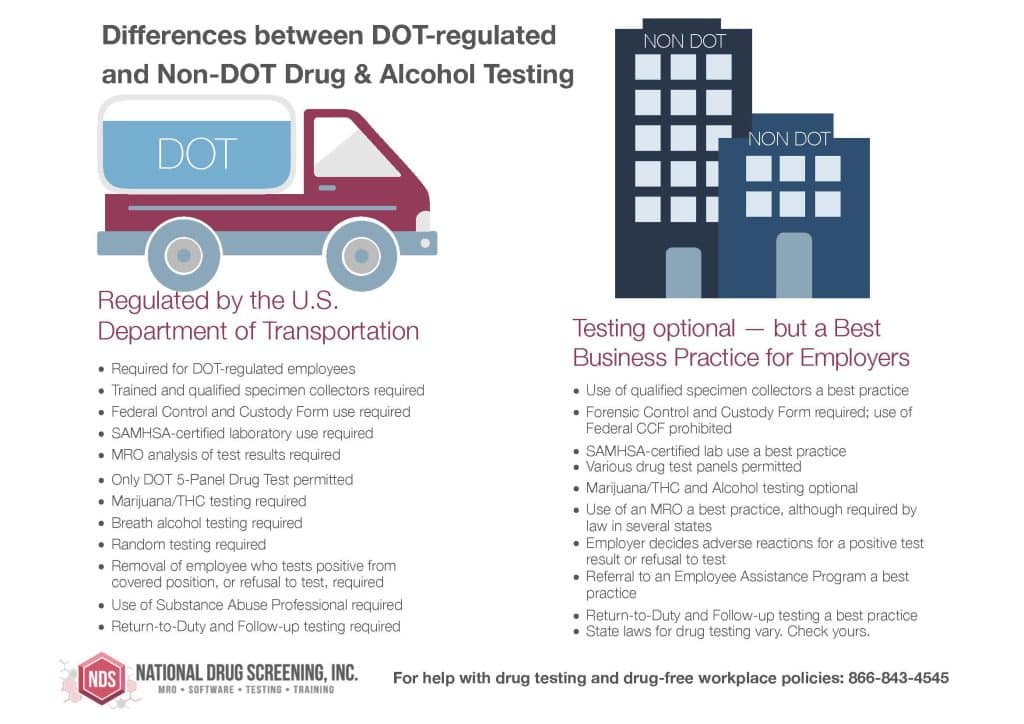Employment drug testing in the United States falls into two major categories and it is important for employers to understand so their companies are compliant with applicable laws and also equipped to build safe work environments guarded against the harms of drug use.
We get this question all the time – What is the difference between a regular drug test and a DOT drug test? In this article we will discuss:
DOT Drug Testing
The first category of employment drug testing, commonly known as “DOT testing,” affects more than 1 million businesses across the nation in which people work in safety-sensitive, transportation-related jobs. DOT testing is required by the federal government and regulated by the United States Department of Transportation (DOT) and its reporting agencies, including the Federal Motor Carrier Safety Administration, the Federal Railroad Administration and the Federal Aviation Administration. Everyone subject to the commercial driver’s license requirements and their employers must follow federal rules for alcohol and drug testing. Those rules govern testing procedures, the frequency of testing and the substances tested for.
Non-DOT Drug Testing
The second category of employment drug testing in the U.S. is often called “non-DOT testing,” — and it is what it sounds like. This testing is neither federally regulated nor required for the more than 30 million non-regulated businesses in the U.S. to conduct. However, millions of employers do maintain and enforce workplace drug-use policies and testing requirements because they want to maximize worker productivity, lower rates of employee absenteeism and workplace injury, and significantly lower their risk of a wide range of liabilities. Non-DOT testing is conducted under an employer’s authority and should follow a program that consistently and lawfully enforces the company’s drug-free workplace policy. Non-DOT testing programs can be modeled after a DOT drug testing program — an approach often called “DOT-like drug testing” — or they could be more customized to meet the employer’s needs.
Quick Overview of DOT and Non-DOT Drug Testing
We get this question all the time: “What are the differences between a regular drug test and a DOT drug test?” To understand the answer, it is smart first to have a command of the federal framework of drug testing requirements.
DOT-regulated employers are subject to drug and alcohol testing stipulated by the Code of Federal Regulations — specifically 49 CFR Part 40, which details how, when and of whom testing should be performed, including:
- collection of specimens;
- laboratory analysis of specimens;
- the Medical Review Officer’s process for specimen review and verification;
- the employer’s responsibilities;
- the Substance Abuse Professional’s requirements and processes for evaluating employees who have failed a DOT drug and alcohol program regulation, and making recommendations for their education, treatment and follow-up testing;
- an employee’s follow-up testing and return to duty; and
- the roles of the Consortia/Third-Party Administrators.
Employees subject to DOT drug testing requirements are often referred to as “covered” or “safety-sensitive” workers. Only these employees should be subject to DOT drug and alcohol testing requirements as outlined by 49 CFR Part 40. DOT-regulated employers have additional regulations to follow based on the DOT agency under which they are further supervised. These include:
- Federal Motor Carrier Safety Administration (FMCSA)
- Federal Aviation Administration (FAA)
- Federal Railroad Administration (FRA)
- Federal Transit Administration (FTA)
- Pipeline and Hazardous Materials Safety Administration (PHMSA)
- U.S. Coast Guard (USCG)
Violations of DOT drug and alcohol testing rules result in an employee’s removal from safety-sensitive work positions and responsibilities and require that the employee be afforded the support of a Substance Abuse Professional’s program and permitted follow-up testing and a possible return to duty.
It is common for employers to have employees who are DOT-regulated and employees who are not. These employers conduct drug and alcohol testing in accordance with federal law and testing that honors the rules of their own company workplace drug policies. DOT test records must be stored separately from non-DOT — or “company authority” — test records.
Differences between DOT and Non-DOT Drug testing
- DOT-regulated employers have employee education and supervisor training requirements. These, in addition to a written policy, are not required for Non-DOT drug testing programs — but they are considered a best practice to reduce liability in any drug testing program.
- A federal drug test Control and Custody Form, or CCF, is used for DOT drug testing; this form always has the word “federal” on the top of the form. This federal form never should be used for non-DOT drug testing. For non-DOT testing, the form is often called a “forensic CCF form.” These forms are not interchangeable.
- A split specimen test is required for DOT drug testing; however, split specimen testing is not required for Non-DOT drug testing.
- DOT drug testing requires a five-panel drug test with a urine specimen and specific drug test consisting of: Marijuana metabolites / THC, Cocaine metabolites, Phencyclidine (PCP),Amphetamines, Methamphetamine, and Methylenedioxymethamphetamine (MDMA) and Opioid metabolites.
- Non-DOT drug testing can be with urine, oral fluid or hair specimens. The above five drugs can be tested for, or additional drugs, such as benzodiazepines, barbiturates, methadone, propoxyphene, Fentanyl or methaqualone (Quaaludes), can be added.
- The cutoff levels for laboratory determination of a positive result may differ between DOT and non-DOT drug testing programs. DOT cutoff levels are set by the Substance Abuse and Mental Health Services Administration (SAMHSA). Non-DOT testing cutoff levels can be set in state laws or, in some cases, not mentioned — making them an employer option.
- Random drug testing is required in DOT drug and alcohol testing programs. However, random testing is optional for a non-DOT drug testing program. Random drug testing can help provide a safer workplace and is a deterrent to illicit drug use.
- Alcohol is a requirement of DOT drug and alcohol testing programs. Alcohol testing is not a requirement of a Non-DOT drug testing program. It is an option for non-DOT-regulated testing.
- Non-DOT testing does not follow 49 CFR Part 40, but employers should be aware of various state laws regarding drug testing in the states in which they operate.
- In some states, a drug testing program can allow the employer to receive a 5 percent discount on workers’ compensation insurance programs.
- The DOT testing program requires a written policy, and this policy should explain fully the DOT drug and alcohol testing program. The policy should be distributed to all employees covered under the company’s DOT drug testing program. Each DOT-regulated employer must have a key employee for drug and alcohol program functions. This person, called the Designated Employer Representative, or DER, is in charge of the company's drug and alcohol testing program. The primary job of the DER is to ensure the appropriate and timely removal of an employee from safety-sensitive duties. This person must be an employee of the company, and this function cannot be outsourced. For non-regulated DOT testing programs, these requirements are best practices.
Comparison Chart DOT vs Non-DOT Drug Testing
- Required for DOT-regulated employers
- Trained and qualified specimen collectors required
- Federal CCF Required
- SAMHSA-certified lab required
- Only DOT 5 panel drug test allowed
- Marijuana testing required
- MRO review of drug test results required
- Random testing required
- Breath alcohol testing required for several test reasons
- Removal of employee from covered position when testing positive, or refusal to test is required
- Substance Abuse Professional (SAP) required
- Return to duty and follow testing required
- DOT program has strict recordkeeping requirements
- Not required, but a good idea
- Use of a trained and qualified specimen collector is a best practice
- Forensic CCF Required, use of Federal CCF prohibited
- Use of SAMHSA-certified Lab is a best practice
- Various drug test panels allowed
- Marijuana testing is optional
- Alcohol testing is optional
- MRO review of results is a best practice, often required by a state law
- Employer decides on adverse actions for a positive test or refusal to test
- Referral to an Employee Assistance Program (EAP) is a best practice
- Return to duty and follow testing is a best practice
For more information on DOT and Non-DOT drug testing programs please visit these pages on our web site:








